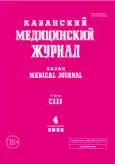Evaluation of the results of neoadjuvant treatment in patients with HER2 positive breast cancer subtype
- Authors: Kaganov O.I.1,2, Orlova A.K.2, Tkachev M.V.1,2
-
Affiliations:
- Samara Regional Clinical Oncology Dispensary
- Samara State Medical University
- Issue: Vol 103, No 4 (2022)
- Pages: 587-591
- Section: Theoretical and clinical medicine
- URL: https://ogarev-online.ru/kazanmedj/article/view/89353
- DOI: https://doi.org/10.17816/KMJ2022-587
- ID: 89353
Cite item
Full Text
Abstract
Background. In women, breast cancer is the most common malignant tumor. Based on current clinical guidelines for HER2 positive tumor growth, it is possible to carry out preoperative chemotherapy for further organ-preserving operations. However, a prognostic scale for assessing neoadjuvant treatment has not yet been developed.
Aim. To create a mathematical model on the basis of which a computer program was developed to determine the likelihood of the neoadjuvant treatment effectiveness in patients diagnosed with HER2 positive breast cancer for further organ-preserving operations.
Material and methods. A planned retrospective study was performed at the Samara Regional Clinical Oncology Dispensary to assess the results of combined treatment of 93 patients diagnosed with breast cancer with HER2-positive tumor growth subtype with organ-preserving operations. The age of the patients was from 31 to 62 years, the mean age was 47.11±9.78 years. Three (15.53%) patients were diagnosed with stage I of the disease according to the TNM system, and 90 (84.47%) — with stage II. A search for statistically significant predictors of achieving morphological regression as a result of preoperative chemotherapy was carried out.
Results. The mathematical model was created in the logistic regression module according to Wald's algorithm. Using SPSS 10.0, stepwise exclusion of predictors was performed. As a result of the multivariate analysis, a mathematical model and the corresponding program for the electronic computer “Calculation of the achievement of complete morphological regression in patients diagnosed with primary operable breast cancer with epidermal growth factor receptors” after neoadjuvant chemotherapy were created. In the future, the evaluation of the effectiveness of this program was compared with the results of 206 patients’ treatment.
Conclusion. The creation of a mathematical model and a computer program made it possible to personalize the most effective treatment regimen for patients diagnosed with HER2 positive breast cancer, depending on the initial characteristics of the tumor.
Full Text
##article.viewOnOriginalSite##About the authors
Oleg I. Kaganov
Samara Regional Clinical Oncology Dispensary; Samara State Medical University
Email: okaganov@yandex.ru
ORCID iD: 0000-0003-1765-6965
M.D., D. Sci. (Med.), Assoc. Prof., Deputy Chief Physician for Research; Head of Depart., Depart. of Oncology
Russian Federation, Samara, Russia; Samara, RussiaAnastasiya K. Orlova
Samara State Medical University
Email: tkachevmv@samaraonko.ru
ORCID iD: 0000-0001-6863-9968
student
Russian Federation, Samara, RussiaMaksim V. Tkachev
Samara Regional Clinical Oncology Dispensary; Samara State Medical University
Author for correspondence.
Email: m9277477577@mail.ru
ORCID iD: 0000-0002-4183-0647
M.D., Cand. Sci. (Med.), Oncologist, Oncology Department (General Oncology); Assistant, Depart. of Oncology
Russian Federation, Samara, Russia; Samara, RussiaReferences
- Semsarzadeh NN, Tadisina KK, Maddox J. Closed incision negative-pressure therapy is associated with decreased surgical-site infections: a meta-analysis. Plast Reconstr Surg. 2015;136:592–602. doi: 10.1097/PRS.0000000000001519.
- Suh H, Lee AY, Park EJ. Negative pressure wound therapy on closed surgical wounds with dead space: animal study using a swine model. Ann Plast Surg. 2016;76:717–722. doi: 10.1097/SAP.0000000000000231.
- Pachowsky M, Gusinde J, Klein A. Negative pressure wound therapy to prevent seromas and treat surgical incisions after total hip arthroplasty. Int Orthop. 2012;36:719–722. doi: 10.1007/s00264-011-1321-8.
- Maksimenko J. Prognostic role of BRCA1 mutation in patients with triple-negative breast cancer. Oncol Lett. 2014;7(1):278–284. doi: 10.3892/ol.2013.1684.
- Jhan JR, Andrechek ER. Triple-negative breast cancer and the potential for targeted therapy. Pharmacogeno¬mics. 2017;18 (17):1595–1609. doi: 10.2217/PGS-2017-0117.
- Dent R, Trudeau M, Pritchard KI. Triple-negative breast cancer: clinical features and patterns of recurrence. Clin Cancer Res. 2007;1(15):4429–4434. doi: 10.1158/1078-0432.CCR-06-3045.
- Schoormans D, Czene K, Hall P, Brandberg Y. The impact of co-morbidity on health-related quality of life in breast cancer survivors and controls. Acta Oncologica. 2015;54:727–734. doi: 10.3109/0284186X.2014.998277.
- De Glas NA, Kiderlen M, Bastiaannet E. Postoperative complications and survival of elderly breast cancer patients: a FOCUS study analysis. Breast Cancer Res Treat. 2013;138:561–569. doi: 10.1007/s10549-013-2462-9.
- Vladi¬mirova LY, Storozhakova AE, Snezhko TA, Strakhova LK, Abramova NA, Kabanov SN, Kalabanova EA, Samaneva NYu, Svetitskaya YaV, Tishina AV. Hormone-positive HER2-negative metastatic breast cancer: decision making in real clinical practice. South Russian journal of cancer. 2020;1(2):46–51. (In Russ.) doi: 10.37748/2687-0533-2020-1-2-6.
- Lebert JM, Lester R, Powell E. Advances in the systemic treatment of triple-negative breast cancer. Curr Oncol. 2018;1(25):142–150. DOI: 10.3747CO.25.3954.
- Khakimova ShG, Zikiryakhodzhayev AD. Choice for a reconstruction method in breast cancer patients. PA Herzen Journal of Oncology. 2021;10(4):53–58. (In Russ.) doi: 10.17116/onkolog20211004153.
- Shkurnikov MYu, Kaprin AD. The role of interactomic interactions in tamo¬xifen-resistant breast cancer: new approaches to searching for the mechanisms of pathogenesis. PA Herzen Journal of Oncology. 2020;9(6):80–85. (In Russ.) doi: 10.17116/onkolog2020906180.
- Abramson VG, Lehmann BD, Ballinger TJ, Pietenpol JA. Subtyping of triple-negative breast cancer: implications for therapy. Cancer. 2015;1(121):8–16. doi: 10.1002/CNCR.28914.
- Orlov AE, Kaganov OI, Saveliev VN, Tkachev MV, Borisov AP, Kruglova PL. A Mathematical Model for Complete Morpholo¬gical Regression in Primary Operable HER2-Positive Breast Cancer. Kreativnaya hirurgiya i onkologiya. 2021;11(1):5–9. (In Russ.) doi: 10.24060/2076-3093-2021-11-1-5-9.
- Tkachev MV, Moryakin IN, Savel'ev VN. Raschet dostizheniya polnogo morfologicheskogo regressa u bol'nyh s diagnozom pervichno-operabel'nyy rak molochnoy zhelezy s retseptorami epidermal'nogo faktora rosta posle neoad"yuvantnoy khimioterapii. Svidetel'stvo o gosudarstvennoj registracii programmy dlya EVM No. 2017660827 from 27.09.2017. (Calculation of achieving complete morphological regression in patients diagnosed with primary operable breast cancer with epidermal growth factor receptors after neoadjuvant chemotherapy. Certificate of state registration of the computer program No. 2017660827 dated September 27, 2017.) (In Russ.)
Supplementary files





